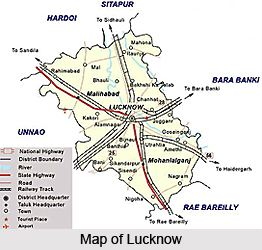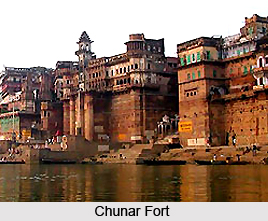 Lucknow District is an administrative district of Uttar Pradesh with its headquarters located at Lucknow. This district forms a part of Lucknow Division. Lucknow is situated at around 123 metres above the sea level. It lies at 26 degree 30 minutes and 27 degree 10 minutes north latitude and 80 degree 30 minutes and 81 degree 13 minutes east longitude. Lucknow covers an area of 2528 sq kms. Lucknow District is surrounded on the eastern side by Barabanki District, on the western side by Unnao District, on the southern side by Rae Bareli District and on the northern side by Sitapur District and Hardoi District.
Lucknow District is an administrative district of Uttar Pradesh with its headquarters located at Lucknow. This district forms a part of Lucknow Division. Lucknow is situated at around 123 metres above the sea level. It lies at 26 degree 30 minutes and 27 degree 10 minutes north latitude and 80 degree 30 minutes and 81 degree 13 minutes east longitude. Lucknow covers an area of 2528 sq kms. Lucknow District is surrounded on the eastern side by Barabanki District, on the western side by Unnao District, on the southern side by Rae Bareli District and on the northern side by Sitapur District and Hardoi District.
History of Lucknow District
According to popular legend, Lord Rama gifted the territory of Lucknow to his devoted brother Lakshmana after he had conquered Sri Lanka and completed his term of exile in the jungle. Therefore, people say that the original name of Lucknow was Lakshmanpur, popularly known as Lakhanpur or Lachmanpur. Avadh is claimed to be among the most ancient of Hindu states. However, there is no record of when and how Ayodhya came to be deserted or allowed to decay. After the conquest of Kannauj by the Afghans at the end of the 12th century, Avadh came under the rule of Sultan of Ghazni, and so became part of the empire of Delhi. As the Mughal power declined the region grew stronger and more independent. It was then ruled by the Nawabs. The Nawabs surrendered their independence little by little over many years during the British rule. To pay for the protection of British forces and assistance in war, Avadh gave up first the fort of Chunar, then the districts of Banaras and Ghazipur, then the fort at Allahabad. Asaf -ud-Daula, son of Shuja-ud- Daula, moved the capital from Faizabad to Lucknow in 1775 and made it one of the most prosperous and glittering cities in the country.
Geography of Lucknow District
Lucknow District has uniformed tropical climate. The temperature varies from 45 degree Celsius in summer to 5 degree Celsius in winter season. Average annual rainfall is 100 cm per annum. Gomti River flows through the city. Some of the tributaries of this river are Kukrail, Loni, Beta, etc. Sai River flows from its southern border.
 The forest area is negligible in the district. Shisham, Dhak, Mahua, Babul, Neem tree, Peepul tree, Ashok, Khajur, Mango and Gular trees are grown here. In fact different varieties of mangoes are grown in the district and exported to other countries too. The main crops are wheat, paddy, sugarcane, mustard, potatoes and vegetables are grown here. Apart from these many medicinal and herbal plants are also grown here.
The forest area is negligible in the district. Shisham, Dhak, Mahua, Babul, Neem tree, Peepul tree, Ashok, Khajur, Mango and Gular trees are grown here. In fact different varieties of mangoes are grown in the district and exported to other countries too. The main crops are wheat, paddy, sugarcane, mustard, potatoes and vegetables are grown here. Apart from these many medicinal and herbal plants are also grown here.
Culture of Lucknow District
Lucknow District is known for its rich culture. Lucknow, the district headquarters, is considered as the golden city of the east. It retains an old charm that fascinates one and all. Regarded as one of the finest cities of India, Lucknow emanates a culture that combines emotional warmth, a high degree of sophistication, courtesy and a love for gracious living. This sublime cultural richness famous as `Lucknowi Tehzeeb` blends the cultures of two communities living side by side for centuries, sharing similar interests, speaking a common language that is Urdu language. Many of the cultural traits and customs of Lucknow have become living legends today. The credit for this goes to the Nawabs of Awadh, who took keen interest in every walk of life and encouraged them to attain a rare degree of perfection. The Nawabs of Awadh were great patrons of fine arts of which the most well known is the exquisite `Chikan work`. Chikan is a unique craft involving delicate and artistic hand embroidery. Various cultural ingredients have contributed to the richness of this unique city. Lucknow became the focal point of a cultural renaissance with the shifting of capital from Faizabad to Lucknow in 1776. No account of the culture of Lucknow is complete without a mention of the famous `Chowk` of Lucknow. `Chowk` has played a vital role in the development of its culture. It is the pivotal point around which the traders, engravers, painters, artisans, weavers, singers and dancers flourished and grew. Like various other art forms the culinary art of Lucknow was also raised to a fine art under royal patronage.
Education in Lucknow District
There are several popular educational institutions in Lucknow District. Lucknow District has Lucknow University and Ambedkar University. Further, there are several degree colleges, engineering and medical institutes, management, fashion technology, research and polytechnic institutes in this district. Moreover, Lucknow District also has various popular secondary schools.
Lucknow is easily accessible from every part of the country through Airways, Railways and Roadways. It is directly connected with Delhi, Patna, Kolkata, Mumbai, Varanasi and other major cities by Amausi International Airport. Similarly city is linked to north, east, south and west through rail and road links.






